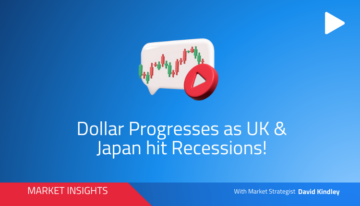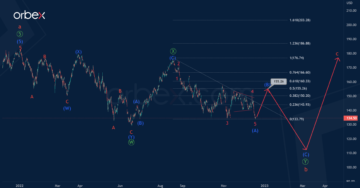Yesterday’s inflation data from the UK came in as a bit of a surprise, causing the markets to swing as traders parsed the data. The initial reaction was to the larger drop in inflation than expected, with CPI going down to the lowest rate on an annual basis since September of 2021. That initially inclined traders to suspect the BOE might be on track to ease sooner.
But a closer look at the figures showed that services inflation came down, but not by as much as expected. Services beat by as much as the headline missed. Over the last couple of months, various members of the BOE’s monetary policy committee have mentioned persistently high services inflation as a problem. That led to a reevaluation of what might happen at tomorrow’s meeting. The so-called “shadow MPC”, which are economists looking to anticipate what the BOE will do, showed a vote of 8-1 to hold.
What to Look Out For
There is a unanimous consensus that the BOE won’t cut rates this time around, despite the slower than expected inflation figures. Economists believe the current rate will be maintained until the third quarter, which is also reflected in the future rates. The markets aren’t pricing in a significant chance of a rate cut until the summer.
Therefore, the focus will likely be on the vote split. We should remember that last time around, there was an extremely rare three-way split supporting both hiking and cutting. Though the vote for easing came from Swati Dinghra, who is known as being extremely dovish and widely expected to keep voting for easing. What will be on the magnifying glass is how many of last month’s hike voters switch to the majority in favor of holding. And if any of the prior holders join Dinghra in supporting easing. That will likely be the gauge of how hawkish or dovish the results are seen.
Pushing or Pulling the Pound?
Gilts have been trading largely range bound for a while as investors try to figure out the path towards disinflation. This has left the interest rate pressures on the pound rather even. That could change depending on the outlook coming out of the BOE. There won’t be an update on the staff projections for key data like inflation and economic growth, which will make it a little harder for the market to consolidate in terms of what to expect at the next meeting.
Given that there is no immediate expectation of a rate hike, there is no pressure on the BOE to be explicit about an imminent change in policy. At the last meeting, the message was that interest rates were restrictive in order to get inflation down, and easing would start as long as a clear disinflation trend is observed. Since then, the status quo has been wait-and-see to get enough data to see if that trend is observed.
Keeping Expectations in Check
With the BOE fighting higher inflation than other central banks, the expectation is that it will be the last of the majors to move towards easing. The market is pricing in only 63bps of rate cuts this year, less than for either the ECB or the Fed. That has kept gilts up, which would otherwise support the pound if it weren’t for the dour outlook for the economy.
Which means that pending the BOE moving to formally ease, the pound could be dependent more on GDP figures than inflation. The market does expect inflation to ease at some point. But there is less certainty about economic growth. If the economy manages a rebound, then gilts could be supported and pull up the pound. But lagging economic growth could likely translate into a weaker pound.
Trading the news requires access to extensive market research – and that’s what we do best.
- SEO Powered Content & PR Distribution. Get Amplified Today.
- PlatoData.Network Vertical Generative Ai. Empower Yourself. Access Here.
- PlatoAiStream. Web3 Intelligence. Knowledge Amplified. Access Here.
- PlatoESG. Carbon, CleanTech, Energy, Environment, Solar, Waste Management. Access Here.
- PlatoHealth. Biotech and Clinical Trials Intelligence. Access Here.
- Source: https://www.orbex.com/blog/en/2024/03/boe-the-last-to-get-around-to-cutting
- :has
- :is
- :not
- $UP
- 2021
- a
- About
- access
- also
- an
- and
- annual
- anticipate
- any
- app
- ARE
- around
- AS
- At
- Banks
- basis
- BE
- beat
- been
- being
- believe
- BEST
- Bit
- Blog
- BoE
- both
- bound
- but
- by
- came
- causing
- central
- Central Banks
- certainty
- Chance
- change
- clear
- closer
- coming
- committee
- Consensus
- consolidate
- could
- Couple
- CPI
- Current
- Cut
- cuts
- cutting
- data
- dependent
- Depending
- Despite
- do
- does
- Dovish
- down
- Drop
- ease
- easing
- ECB
- Economic
- Economic growth
- economists
- economy
- either
- enough
- Ether (ETH)
- Even
- expect
- expectation
- expectations
- expected
- extensive
- extremely
- favor
- Fed
- fighting
- Figure
- Figures
- Focus
- For
- Formally
- from
- future
- gauge
- GDP
- get
- glass
- going
- Growth
- happen
- harder
- Have
- Hawkish
- headline
- High
- higher
- Hike
- hiking
- hold
- holders
- holding
- How
- HTTPS
- if
- image
- immediate
- in
- Inclined
- inflation
- inflation figures
- initial
- initially
- interest
- INTEREST RATE
- Interest Rates
- into
- Investors
- IT
- join
- Keep
- kept
- Key
- known
- lagging
- largely
- larger
- Last
- Led
- left
- less
- like
- likely
- little
- live
- Long
- Look
- looking
- lowest
- maintained
- Majority
- Majors
- make
- manages
- many
- Market
- market research
- Markets
- means
- meeting
- Members
- mentioned
- message
- might
- missed
- Mobile
- Mobile app
- Monetary
- Monetary Policy
- monetary policy committee
- months
- more
- move
- moving
- much
- news
- next
- no
- observed
- of
- on
- only
- or
- order
- Other
- otherwise
- out
- Outlook
- over
- path
- pending
- persistently
- plato
- Plato Data Intelligence
- PlatoData
- Point
- policy
- pound
- pressure
- pressures
- pricing
- Prior
- Problem
- projections
- pulling
- Quarter
- range
- RARE
- Rate
- Rate Hike
- Rates
- rather
- reaction
- rebound
- reflected
- remember
- requires
- research
- Restrictive
- Results
- see
- seen
- September
- Services
- should
- showed
- significant
- since
- slower
- some
- split
- Staff
- start
- Status
- summer
- support
- Supported
- Supporting
- surprise
- Swing
- Switch
- terms
- than
- that
- The
- the Fed
- The Future
- the UK
- then
- There.
- Third
- this
- though?
- time
- to
- towards
- track
- Traders
- Trading
- translate
- Trend
- try
- Uk
- until
- Update
- URL
- various
- Vote
- voters
- Voting
- was
- we
- weaker
- were
- What
- which
- while
- WHO
- widely
- will
- with
- would
- zephyrnet













